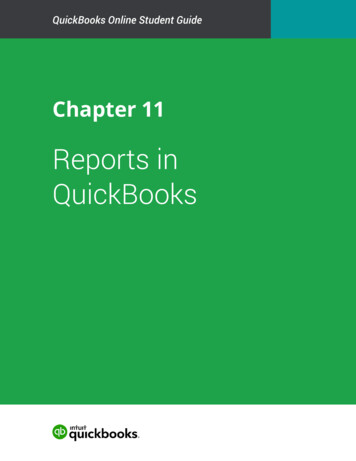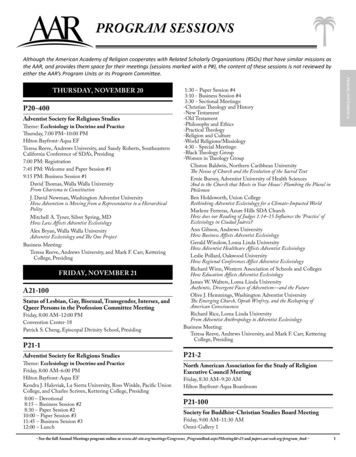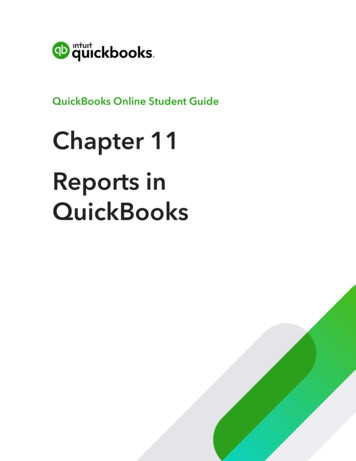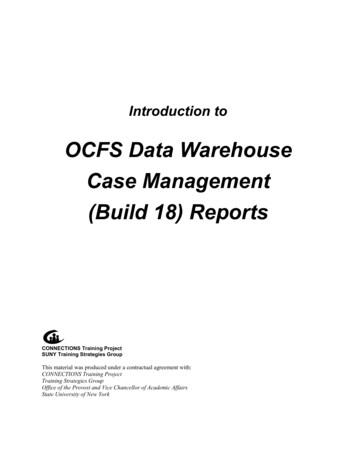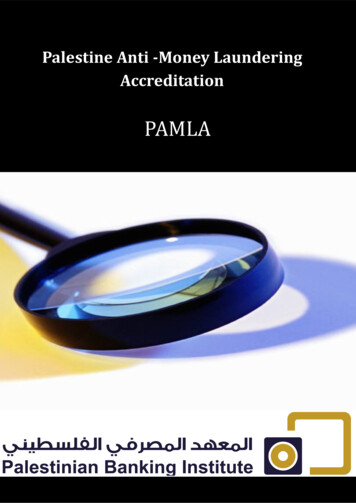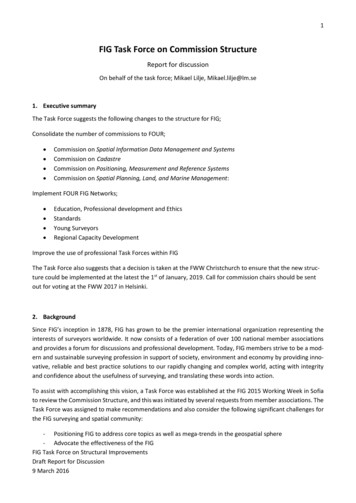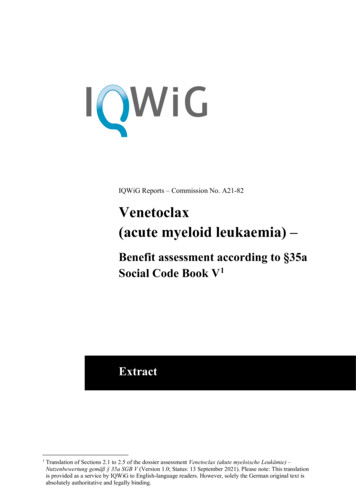
Transcription
IQWiG Reports – Commission No. A21-82Venetoclax(acute myeloid leukaemia) –Benefit assessment according to §35aSocial Code Book V1Extract1Translation of Sections 2.1 to 2.5 of the dossier assessment Venetoclax (akute myeloische Leukämie) –Nutzenbewertung gemäß § 35a SGB V (Version 1.0; Status: 13 September 2021). Please note: This translationis provided as a service by IQWiG to English-language readers. However, solely the German original text isabsolutely authoritative and legally binding.
Extract of dossier assessment A21-82Venetoclax (acute myeloid leukaemia)Version 1.013 September 2021Publishing detailsPublisherInstitute for Quality and Efficiency in Health CareTopicVenetoclax (acute myeloid leukaemia) – Benefit assessment according to §35a Social CodeBook VCommissioning agencyFederal Joint CommitteeCommission awarded on15 June 2021Internal Commission No.A21-82Address of publisherInstitut für Qualität und Wirtschaftlichkeit im GesundheitswesenIm Mediapark 850670 KölnGermanyPhone: 49 221 35685-0Fax: 49 221 35685-1E-mail: berichte@iqwig.deInternet: www.iqwig.deInstitute for Quality and Efficiency in Health Care (IQWiG)-i-
Extract of dossier assessment A21-82Venetoclax (acute myeloid leukaemia)Version 1.013 September 2021Medical and scientific advice Ingo Schmidt-Wolf, University Hospital, Bonn, GermanyIQWiG thanks the medical and scientific advisor for his contribution to the dossier assessment.However, the advisor was not involved in the actual preparation of the dossier assessment. Theresponsibility for the contents of the dossier assessment lies solely with IQWiG.IQWiG employees involved in the dossier assessment Selver Altin Christiane Balg Charlotte Hecker Katrin Nink Sabine Ostlender Mattea Patt Dorothea Sow Katharina WölkeKeywords: Venetoclax, Leukemia – Myeloid – Acute, Benefit Assessment, NCT02993523Institute for Quality and Efficiency in Health Care (IQWiG)- ii -
Extract of dossier assessment A21-82Venetoclax (acute myeloid leukaemia)Version 1.013 September 2021Table of contentsPageList of tables . ivList of abbreviations. v2 Benefit assessment . 12.1 Executive summary of the benefit assessment . 12.2 Research question . 62.3 Information retrieval and study pool . 62.3.1 Studies included . 72.3.2 Study characteristics . 72.4 Results on added benefit . 212.4.1 Outcomes included . 212.4.2 Risk of bias . 252.4.3 Results . 272.4.4 Subgroups and other effect modifiers. 312.5 Probability and extent of added benefit . 312.5.1 Assessment of the added benefit at outcome level . 312.5.2 Overall conclusion on added benefit . 34References for English extract . 37Institute for Quality and Efficiency in Health Care (IQWiG)- iii -
Extract of dossier assessment A21-82Venetoclax (acute myeloid leukaemia)Version 1.013 September 2021List of tables 2PageTable 2: Research question of the benefit assessment of venetoclax in combination withan HMA . 1Table 3: Venetoclax in combination with an HMA – probability and extent of addedbenefit . 5Table 4: Research question of the benefit assessment of venetoclax in combination withan HMA . 6Table 5: Study pool – RCT, direct comparison: venetoclax azacitidine vs. placebo azacitidine . 7Table 6: Characteristics of the study included – RCT, direct comparison: venetoclax azacitidine vs. placebo azacitidine . 8Table 7: Characteristics of the intervention – RCT, direct comparison: venetoclax azacitidine vs. placebo azacitidine . 10Table 8: Planned duration of follow-up observation – RCT, direct comparison: venetoclax azacitidine vs. placebo azacitidine . 14Table 9: Characteristics of the study population – RCT, direct comparison: venetoclax azacitidine vs. placebo azacitidine (relevant subpopulation) . 16Table 10: Information on the course of the study – RCT, direct comparison: venetoclax azacitidine vs. placebo azacitidine . 19Table 11: Risk of bias across outcomes (study level) – RCT, direct comparison:venetoclax azacitidine vs. placebo azacitidine . 20Table 12: Matrix of outcomes – RCT, direct comparison: venetoclax azacitidine vs.placebo azacitidine . 22Table 13: Risk of bias across outcomes and outcome-specific risk of bias – RCT, directcomparison: venetoclax azacitidine vs. placebo azacitidine . 26Table 14: Results (mortality, morbidity, health-related quality of life, side effects) – RCT,direct comparison: venetoclax azacitidine vs. placebo azacitidine . 28Table 15: Extent of added benefit at outcome level: venetoclax azacitidine vs. placebo azacitidine . 33Table 16: Positive and negative effects from the assessment of venetoclax azacitidine incomparison with azacitidine (relevant subpopulation) . 34Table 17: Venetoclax in combination with an HMA – probability and extent of addedbenefit . 352Table numbers start with “2” as numbering follows that of the full dossier assessment.Institute for Quality and Efficiency in Health Care (IQWiG)- iv -
Extract of dossier assessment A21-82Venetoclax (acute myeloid leukaemia)Version 1.013 September 2021List of abbreviationsAbbreviationACTMeaningappropriate comparator therapyAEadverse eventAMLacute myeloid leukaemiaCRcomplete remissionCRicomplete remission with incomplete blood count recoveryCTCAECommon Terminology Criteria for Adverse EventsDGHODeutsche Gesellschaft für Hämatologie und Medizinische Onkologie(German Society for Haematology and Medical Oncology)ECOG PSEastern Cooperative Oncology Group Performance StatusELNEuropean LeukemiaNetEORTC QLQC30European Organisation for Research and Treatment of Cancer Quality ofLife Questionnaire-Core 30EQ-5DEuropean Quality of Life Questionnaire-5 DimensionsESMOEuropean Society for Medical OncologyEUEuropean UnionFDAUnited States Food and Drug AdministrationG-BAGemeinsamer Bundesausschuss (Federal Joint Committee)HMAhypomethylating agentIQWiGInstitut für Qualität und Wirtschaftlichkeit im Gesundheitswesen(Institute for Quality and Efficiency in Health Care)LDAClow-dose cytarabineMMRMmixed-effects model with repeated measuresNCCNNational Comprehensive Cancer NetworkPROMIS Cancer Patient-Reported Outcome Measurement Information System CancerFatigue SF 7aFatigue Short Form 7aPTPreferred TermRCTrandomized controlled trialSAEserious adverse eventSGBSozialgesetzbuch (Social Code Book)SOCSystem Organ ClassSPCSummary of Product CharacteristicsULNupper limit of normalVASvisual analogue scaleWHOWorld Health OrganizationInstitute for Quality and Efficiency in Health Care (IQWiG)-v-
Extract of dossier assessment A21-82Venetoclax (acute myeloid leukaemia)22.1Version 1.013 September 2021Benefit assessmentExecutive summary of the benefit assessmentBackgroundIn accordance with §35a Social Code Book (SGB) V, the Federal Joint Committee (G-BA)commissioned the Institute for Quality and Efficiency in Health Care (IQWiG) to assess thebenefit of the drug venetoclax. The assessment is based on a dossier compiled by thepharmaceutical company (hereinafter referred to as the “company”). The dossier was sent toIQWiG on 15 June 2021.Research questionThe aim of the present report is the assessment of the added benefit of venetoclax incombination with a hypomethylating agent (HMA) in comparison with the appropriatecomparator therapy (ACT) in patients with newly diagnosed acute myeloid leukaemia (AML)who are ineligible for intensive chemotherapy.The research question presented in Table 2 resulted from the ACT specified by the G-BA.Table 2: Research question of the benefit assessment of venetoclax in combination with anHMATherapeutic indicationaACTbAdult patients with newly diagnosed acute myeloidleukaemia who are ineligible for intensivechemotherapyCytarabine or azacitidine or decitabinea. The G-BA assumes that for all patients in the therapeutic indication at the time of therapy with venetoclax incombination with an HMA, best supportive care treatment alone is not an option. In addition, it is assumedthat patients with acute promyelocytic leukaemia are not comprised by the therapeutic indication.b. Presentation of the respective ACT specified by the G-BA. In cases where the company, because of theG-BA’s specification of the ACT, could choose a comparator therapy from several options, the respectivechoice of the company is printed in bold.ACT: appropriate comparator therapy; G-BA: Federal Joint Committee; HMA: hypomethylating agentThe company followed the G-BA’s specification and chose azacitidine as ACT from the optionspresented.The assessment was conducted by means of patient-relevant outcomes on the basis of the dataprovided by the company in the dossier. Randomized controlled trials (RCTs) were used for thederivation of the added benefit.Study pool and study designFor the assessment of the added benefit of venetoclax in combination with an HMA, the VialeA study is included, which compared the combination of venetoclax and azacitidine (hereinafterreferred to as “venetoclax azacitidine”) with the combination of placebo and azacitidineInstitute for Quality and Efficiency in Health Care (IQWiG)-1-
Extract of dossier assessment A21-82Venetoclax (acute myeloid leukaemia)Version 1.013 September 2021(hereinafter referred to as “placebo azacitidine”). No data are available for the comparison ofthe combination of venetoclax with another HMA against the ACT.The Viale-A study is a randomized, double-blind and multicentre study on the comparison ofvenetoclax azacitidine with placebo azacitidine.The study included treatment-naive adult patients with AML (according to the World HealthOrganization [WHO] criteria) who were ineligible for treatment with a standard cytarabine andanthracycline induction regimen. In the study, non-eligibility for standard induction therapywas defined on the basis of criteria regarding age and/or comorbidities.Patients 75 years of age could have an Eastern Cooperative Oncology Group PerformanceStatus (ECOG PS) of 0–2, patients 18 to 74 years of age an ECOG PS of 0–3. In addition,only patients with intermediate or poor cytogenetic risk (according to the NationalComprehensive Cancer Network [NCCN] classification) were enrolled.The Viale-A study included a total of 433 patients, who were randomly allocated in a 2:1 ratioeither to treatment with venetoclax azacitidine (N 287) or to placebo azacitidine(N 146).In the Viale-A study, treatment with venetoclax and azacitidine was administered in cycles of28 days and was largely in compliance with the recommendations of the Summaries of ProductCharacteristics (SPCs).Coprimary outcomes of the Viale-A study were overall survival and composite completeremission (complete remission [CR] complete remission with incomplete blood countrecovery [CRi]). Patient-relevant secondary outcomes were outcomes on morbidity, healthrelated quality of life and adverse events (AEs).Relevant subpopulation of the Viale-A studyThe Viale-A study included patients who were ineligible for intensive standard inductiontherapy. In Module 4 A, the company referred to 2 consultations with the G-BA, according towhich the inclusion criteria used in the Viale-A study are not fully suitable for identifyingpatients who are ineligible for intensive chemotherapy. Due to this, the company presentedanalyses of a subpopulation from the Viale-A study in Module 4 A. In comparison with theinclusion criteria of the study, the company applied narrower criteria for defining non-eligibilityfor treatment with intensive chemotherapy to form the subpopulation. The subpopulationcomprises 313 (72.3% of the total population) patients (intervention arm N 210; comparatorarm N 103).The approach of the company to forming the subpopulation is considered appropriate. Thesubpopulation formed by the company is therefore used for the present benefit assessment.Institute for Quality and Efficiency in Health Care (IQWiG)-2-
Extract of dossier assessment A21-82Venetoclax (acute myeloid leukaemia)Version 1.013 September 2021Risk of biasThe risk of bias across outcomes was rated as low for the Viale-A study. Except for overallsurvival and discontinuation due to AEs, the outcome-specific risk of bias was rated as high forthe results of all outcomes for which usable data are available. The certainty of results for theoutcome “discontinuation due to AEs” was restricted despite a low risk of bias. A high certaintyof results can be assumed for the outcome “severe AEs” despite a high risk of bias.ResultsMortalityOverall survivalA statistically significant difference in favour of venetoclax azacitidine compared withplacebo azacitidine was shown for the outcome “overall survival”. This resulted in anindication of an added benefit of venetoclax azacitidine in comparison with azacitidine.MorbiditySymptoms (recorded with the European Organisation for Research and Treatment of CancerQuality of Life Questionnaire-Core 30 [EORTC QLQ-C30])There were no usable data for the outcome “symptoms”, recorded with the EORTC QLQ-C30.This resulted in no hint of an added benefit of venetoclax azacitidine in comparison withazacitidine; an added benefit is therefore not proven.Health status (recorded with the European Quality of Life Questionnaire-5 Dimensions[EQ-5D] visual analogue scale [VAS])There were no usable data for the outcome “health status”, recorded with the EQ-5D VAS. Thisresulted in no hint of an added benefit of venetoclax azacitidine in comparison withazacitidine; an added benefit is therefore not proven.Health-related quality of lifeEORTC QLQ-C30There were no usable data for the outcome “health-related quality of life”, recorded with theEORTC QLQ-C30. This resulted in no hint of an added benefit of venetoclax azacitidine incomparison with azacitidine; an added benefit is therefore not proven.Side effectsSerious AEs (SAEs), severe AEs (Common Terminology Criteria for Adverse Events [CTCAE]grade 3) and discontinuation due to AEsThere was no statistically significant difference between the treatment groups for any of theoutcomes “SAEs”, “severe AEs” and “discontinuation due to AEs”. In each case, this resultedin no hint of greater or lesser harm from venetoclax azacitidine in comparison withazacitidine; greater or lesser harm is therefore not proven.Institute for Quality and Efficiency in Health Care (IQWiG)-3-
Extract of dossier assessment A21-82Venetoclax (acute myeloid leukaemia)Version 1.013 September 2021Specific AEsContusion (AE), injury, poisoning and procedural complications (severe AEs)A statistically significant difference in favour of venetoclax azacitidine in comparison withplacebo azacitidine was shown for the specific AEs “contusion” (AE) and “injury, poisoningand procedural complications” (severe AEs). In each case, this resulted in a hint of lesser harmfrom venetoclax azacitidine in comparison with azacitidine.Neutropenia (severe AEs)A statistically significant difference to the disadvantage of venetoclax azacitidine incomparison with placebo azacitidine was shown for the outcome “neutropenia” (composedof neutropenia, neutrophil count decreased, febrile neutropenia, agranulocytosis, neutropenicinfection, neutropenic sepsis; [severe AEs]). This resulted in a hint of greater harm fromvenetoclax azacitidine in comparison with azacitidine.Probability and extent of added benefit, patient groups with therapeutically importantadded benefit 3On the basis of the results presented, probability and extent of the added benefit of the drugvenetoclax in combination with an HMA in comparison with the ACT are assessed as follows:The overall consideration shows both positive and negative effects of venetoclax azacitidinein comparison with azacitidine.On the side of positive effects, there is an indication of a major added benefit for the outcome“overall survival”, and a hint of lesser harm of minor or considerable extent for specific AEs ofdifferent severity categories. On the side of negative effects, in contrast, there is a hint of greaterharm of major extent for the outcome “severe neutropenia”, which in particular does notcompletely call into question the positive effect in overall survival, however.There were no usable data for the outcome categories of morbidity and health-related qualityof life.In summary, there is an indication of considerable added benefit of venetoclax in combinationwith an HMA in comparison with azacitidine for patients with newly diagnosed AML who areineligible for intensive chemotherapy.3On the basis of the scientific data analysed, IQWiG draws conclusions on the (added) benefit or harm of anintervention for each patient-relevant outcome. Depending on the number of studies analysed, the certainty oftheir results, and the direction and statistical significance of treatment effects, conclusions on the probability of(added) benefit or harm are graded into 4 categories: (1) “proof”, (2) “indication”, (3) “hint”, or (4) none of thefirst 3 categories applies (i.e., no data available or conclusions 1 to 3 cannot be drawn from the available data).The extent of added benefit or harm is graded into 3 categories: (1) major, (2) considerable, (3) minor (inaddition, 3 further categories may apply: non-quantifiable extent of added benefit, added benefit not proven, orless benefit). For further details see [1,2].Institute for Quality and Efficiency in Health Care (IQWiG)-4-
Extract of dossier assessment A21-82Venetoclax (acute myeloid leukaemia)Version 1.013 September 2021Table 3 shows a summary of probability and extent of the added benefit of venetoclax.Table 3: Venetoclax in combination with an HMA – probability and extent of added benefitTherapeutic indicationaACTbAdult patients with newlyCytarabine or azacitidine ordiagnosed acute myeloid leukaemia decitabinewho are ineligible for intensivechemotherapyProbability and extent of addedbenefitIndication of considerable addedbenefitca. The G-BA assumes that for all patients in the therapeutic indication at the time of therapy with venetoclax incombination with an HMA, best supportive care treatment alone is not an option. In addition, it is assumedthat patients with acute promyelocytic leukaemia are not comprised by the therapeutic indication.b. Presentation of the respective ACT specified by the G-BA. In cases where the company, because of theG-BA’s specification of the ACT, could choose a comparator therapy from several options, the respectivechoice of the company is printed in bold.c. In the Viale-A study, only venetoclax in combination with azacitidine was investigated; Module 4 A containsno data for the combination with decitabine. It remains unclear whether the observed effects from theViale-A study can be transferred to the combination of venetoclax decitabine.ACT: appropriate comparator therapy; G-BA: Federal Joint Committee; HMA: hypomethylating agentThe approach for the derivation of an overall conclusion on the added benefit is a proposal byIQWiG. The G-BA decides on the added benefit.Supplementary note on the appropriate comparator therapyThe G-BA changed the ACT after submission of the dossier. The change included glasdegib incombination with low-dose cytarabine as additional option, whereas cytarabine alone is nolonger an option of the ACT. The present benefit assessment was based on the originallyspecified ACT. The use of the modified ACT would have no effects on the result of this benefitassessment.Institute for Quality and Efficiency in Health Care (IQWiG)-5-
Extract of dossier assessment A21-82Venetoclax (acute myeloid leukaemia)2.2Version 1.013 September 2021Research questionThe aim of the present report is the assessment of the added benefit of venetoclax incombination with an HMA in comparison with the ACT in patients with newly diagnosed AMLwho are ineligible for intensive chemotherapy.The research question presented in Table 4 resulted from the ACT specified by the G-BA.Table 4: Research question of the benefit assessment of venetoclax in combination with anHMATherapeutic indicationaACTbAdult patients with newly diagnosed acute myeloidleukaemia who are ineligible for intensivechemotherapyCytarabine or azacitidine or decitabinea. The G-BA assumes that for all patients in the therapeutic indication at the time of therapy with venetoclax incombination with an HMA, best supportive care treatment alone is not an option. In addition, it is assumedthat patients with acute promyelocytic leukaemia are not comprised by the therapeutic indication.b. Presentation of the respective ACT specified by the G-BA. In cases where the company, because of theG-BA’s specification of the ACT, could choose a comparator therapy from several options, the respectivechoice of the company is printed in bold.ACT: appropriate comparator therapy; G-BA: Federal Joint Committee; HMA: hypomethylating agentThe company followed the G-BA’s specification and chose azacitidine as ACT from the optionspresented.The assessment was conducted by means of patient-relevant outcomes on the basis of the dataprovided by the company in the dossier. RCTs were used for the derivation of the added benefit.This concurs with the company’s inclusion criteria.2.3Information retrieval and study poolThe study pool of the assessment was compiled on the basis of the following information:Sources of the company in the dossier: study list on venetoclax (status: 6 April 2021) bibliographical literature search on venetoclax (last search on 6 April 2021) search in trial registries/trial results databases for studies on venetoclax (last search on6 April 2021) search on the G-BA website for venetoclax (last search on 6 April 2021)To check the completeness of the study pool: search in trial registries for studies on venetoclax (last search on 25 June 2021); for searchstrategies, see Appendix A of the full dossier assessmentInstitute for Quality and Efficiency in Health Care (IQWiG)-6-
Extract of dossier assessment A21-82Venetoclax (acute myeloid leukaemia)Version 1.013 September 2021The check did not identify any additional relevant study.2.3.1Studies includedThe study presented in the following table was included in the benefit assessment.Table 5: Study pool – RCT, direct comparison: venetoclax azacitidine vs. placebo azacitidineStudyStudy categoryStudy M15-656(Viale-Ad)Available sourcesStudy for theapproval ofthe drug tobe tion])(yes/no[citation])Publicationand othersourcesc(yes/no[citation])NoYes [3]Yes [4,5]Yes [6,7]a. Study for which the company was sponsor.b. Citation of the study registry entries and, if available, of the reports on study design and/or results listed inthe study registries.c. Other sources: documents from the search on the G-BA website and other publicly available sources.d. In the following tables, the study is referred to with this abbreviated form.CSR: clinical study report; G-BA: Federal Joint Committee; RCT: randomized controlled trialFor the benefit assessment of venetoclax in combination with an HMA, the Viale-A study isincluded, which directly compared the combination of venetoclax and azacitidine (hereinafterreferred to as “venetoclax azacitidine”) with the combination of placebo and azacitidine(hereinafter referred to as “placebo azacitidine”). No data are available for the comparison ofthe combination of venetoclax with another HMA against the ACT. The study pool of thepresent benefit assessment concurs with that of the company.2.3.2Study characteristicsTable 6 and Table 7 describe the study used for the benefit assessment.Institute for Quality and Efficiency in Health Care (IQWiG)-7-
Extract of dossier assessment A21-82Venetoclax (acute myeloid leukaemia)Version 1.013 September 2021Table 6: Characteristics of the study included – RCT, direct comparison: venetoclax azacitidine vs. placebo azacitidine (multipagetable)StudyStudy design PopulationInterventions (number ofrandomized patients)Study durationViale-ARCT, Adult patients withpreviously untreateddouble-blindb,AMLc who areparallelineligible fortreatment with astandard cytarabineand anthracyclineinduction regimen: age 75 years or age 18–74 yearsand at least onecomorbidityd ECOG PS 2 forpatients 75 yearsof age ECOG PS 3 forpatients 18–74 yearsof ageVenetoclax azacitidine(N 287e)Placebo azacitidine(N 146e)Screening: up to 21 daysSubpopulation analysed bythe company:Venetoclax azacitidine(n 210)Placebo azacitidine(n 103)Institute for Quality and Efficiency in Health Care (IQWiG)Location and period of study134 centres in Australia,Austria, Belgium, Brazil,Canada, China, Croatia, CzechTreatment:f 6 cycles or until disease Republic, Denmark, Finland,progressiong, unacceptable France, Germany, Hungary,Israel, Italy, Japan, Norway,toxicity, treatmentdiscontinuation following Poland, Portugal, Russia, SouthAfrica, South Korea, Spain,the physician’s orSweden, Taiwan, Turkey, USApatient’s decisionObservationh:outcome-specific, at mostuntil 2 years afterenrolment of the lastpatientPrimary outcome;secondary outcomesaPrimaryl: overallsurvival, CR CRiSecondary: morbidity,health-related qualityof life, AEs2/2017–ongoingFirst data cut-offi:1 October 2018Second data cut-offj:4 January 2020Third data cut-offk:4 July 2020-8-
Extract of dossier assessment A21-82Venetoclax (acute myeloid leukaemia)Version 1.013 September 2021Table 6: Characteristics of the study included – RCT, direct comparison: venetoclax azacitidine vs. placebo azacitidine (multipagetable)StudyStudy design PopulationInterventions (number ofrandomized patients)Study durationLocation and period of studyPrimary outcome;secondary outcomesaa. Primary outcomes include information without consideration of the relevance for this benefit assessment. Secondary outcomes only include information on relevantavailable outcomes for this benefit assessment.b. Up to 12 Chinese patients were included in the study in an unblinded fashion to assess the safety and pharmacokinetics of venetoclax in combination withazacitidine in the Chinese population. This part of the Chinese population was not included in the analyses on efficacy and safety of the blinded study phase and istherefore no longer shown in the next tables.c. Diagnosis confirmed by WHO criteria [8].d. According to the inclusion criteria, 1 of the following criteria had to be met: ECOG PS of 2–3, cardiac failure requiring treatment, ejection fraction 50%,chronic stable angina pectoris, diffusing capacity of the lungs for carbon monoxide 65%, forced expiratory volume in 1 second 65%, creatinine clearance 30to 45 mL/min,, moderate hepatic impairment (total bilirubin 1.5 to 3.0 x ULN) or any other comorbidity that the investigator judges to be incompatible withintensive chemotherapy and was confirmed by the clinical monitor before study enrolment.e. Each of both study arms includes one patient who was enrolled according to the original protocol. The remaining study population (N 286 in the interventionarm; N 145 in the comparator arm) were enrolled after introduction of the first amendment (on 21 De
Social Code Book V. 1. Extract of dossier assessment A21-82 Version 1.0 Venetoclax (acute myeloid leukaemia) 13 September 2021 . direct comparison: venetoclax azacitidine vs. placebo azacitidine . 7 Table 6: Characteristics of the study included - RCT, direct comparison: venetoclax azacitidine vs. placebo azacitidine .
